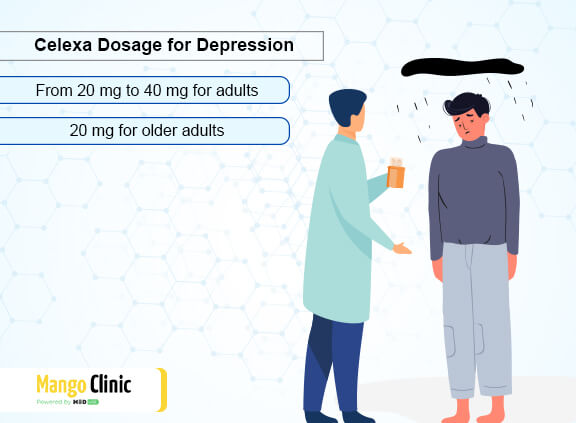How Celexa Helps with Depression

Depression is a common mental disorder that may develop in anyone. According to the National Institute of Mental Health, 8.4% of adults experienced a major depressive episode in the U.S in 2020. Of the two genders, it majorly affected women at a 10.5% prevalence compared to men at 6.2%. Adults aged between 18-25 were the ones experiencing more of the episodes. This indicates how depression is cropping up to becoming one of the big problems in our society.
In most severe cases, depression affects one’s both mental and physical health and results in difficulty socializing and coping with life’s challenges. The risks are especially high if the condition is left untreated.
Lucky enough, there are treatments for depression, including medications. One common drug prescribed for this disorder is Celexa. From this article, you will know how Celexa helps with depression and its treatment methodologies.
But first, let’s understand more about this drug.
Consider seeing a doctor if you experience any unpleasant and worrying mental health symptoms.
What Is Celexa?
Celexa, also known as Citalopram, is a type of antidepressant called a selective serotonin reuptake inhibitor (SSRI). It consists of two stereo-isomers (compounds with the same chemical formula but different atomic arrangements), namely:
- S-citalopram
- R-citalopram
The FDA approves Celexa for treating a major depressive disorder in adults. It is also used off-label for anxiety, OCD, premenstrual dysphoric disorder (PMDD), and post-traumatic stress disorder.
How Does Citalopram Work?
Being a selective serotonin reuptake inhibitor, Celexa works by increasing levels of serotonin chemical compounds in the brain. Serotonin is a hormone that affects mood, sleep, and metabolism. It serves as a neurotransmitter-a chemical messenger which sends signals between nerve cells.
Serotonin is naturally produced by brain nerve cells and released in the gaps between them. It then sends signals between nerves and other body parts, or it enters a reuptake pump and is reabsorbed in the nerve cell that released it. The drawback of this process is that it decreases the quantity of serotonin available to convey signals between nerve cells.

As an SSRI, Celexa prevents the reuptake pump from working, increasing the amount of serotonin that is accessible. Hence it allows more signals to be sent, improving mood, sleep, thinking, and other functions and processes.
Celexa only targets serotonin in its activity, preventing interference with other chemicals in the brain.
Medications may work differently for different patients. Connect with a prescriber to get a drug that will suit you best,
How to Take Celexa for Depression
Celexa is available in both liquid and tablet form. You ingest it based on your doctor’s prescription. It is usually taken once a day with or without food in low doses at the start and gradually increases over several weeks.
The tablets’ dose ranges from 20 to 40 mg once daily and 20 mg once daily for patients older than 60.
The liquid is to be measured using an oral syringe or a dosing spoon to get an accurate intake of the recommended dose.
As a patient, consider sticking to the drug-intake routine throughout the medication. If you forget to take the drug at the specified time, doctors recommend taking it as soon as you remember to prevent withdrawal symptoms.
Other guidelines to consider while taking Citalopram include:
- Not taking other medications that include escitalopram.
- Avoiding operating heavy machinery as the drug may make you tired and drowsy.
- Avoidance of intake of alcohol since such a combination impairs your judgment, coordination, and performance.
How Long Will It Take for You to Feel Better?
It typically takes around four to six weeks for people to start feeling the full effects of Celexa. This is because it can take a while for the brain to adjust to the new levels of serotonin. However, some people may start feeling better after just a few days or weeks.
Sleep, energy, and appetite may improve in the first 1-2 weeks, while low mood and interest in activities might take 6-8 weeks to improve fully.
If you don’t start feeling better after six weeks, your doctor may increase your dosage or switch you to a different medication.

Common Side Effects of Citalopram
Like any other antidepressant drug, Citalopram intake has several side effects on a patient’s body. Some happen as early as the first week of ingesting the drugs. They are grouped into two:
1. Common side effects:
- Increased sweating
- Diarrhea
- Headaches
- Nausea
- Restlessness
- Fatigue
- Dry mouth
- Loss of appetite
- Shaking
2. Severe side effects:
- Abnormal heart rhythms
- Sexual dysfunction
- Seizures
- Bleeding
- Manic episodes
Severe side effects of Celexa are rare, making it one of the best drugs with fewer side effects than other antidepressants.
Final Take
Depression, if left untreated, may cause severe effects and even lead to suicide. With the use of psychotherapy and proper medications such as Celexa, you’ll be sure to manage your symptoms. The medication’s fewer side effects make it tolerable to many patients. Patients are advised to work closely with their doctors to adjust treatment when needed. Contact Mango Clinic today and start your journey to relief.









